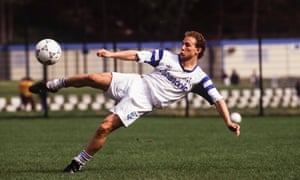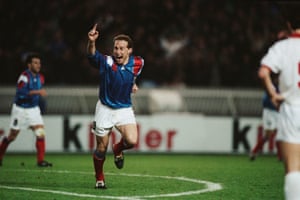[ad_1]
Karim Benzema has been publicly reflecting, let’s say, on France’s ability to win the World Cup with a “go-kart” of a striker, Olivier Giroud. He might also recall Stéphane Guivarc’h, who led the line for France in 1998. For their two World Cup triumphs, France have had centre-forwards who went through the whole tournaments without finding the net. In the early 90s, on the other hand, they had one of the deadliest finishers the game has seen – and they made fools of themselves on the international stage. Go-kart? Go figure.
Jean-Pierre Papin won the Ballon d’Or by a landslide in 1991 and, despite Neymar’s best efforts, remains the only player to receive that accolade while playing for a French club. But his reputation has withered a little and, outside France, he is perhaps the least well remembered recipient of the award for the past 30 years because he never made a mark on a major tournament.
France flopped repeatedly and absurdly when he was in his prime even though he struck 34 times in 50 appearances for his country. At club level Marseille were one of the most thrilling teams in Europe when he was firing in goals for them and even reached the Champions League final in 1991; but when they finally won the tournament in 1993, Papin was a playing-substitute for the opposition, Milan. So Papin, even more than the injury-riddled Michael Owen, is the player who inspires the question: can a Ballon d’Or winner be a nearly man?
But pondering does not seem right when it comes to Papin, because what made him so dangerous and exciting was the complete absence of contemplation in the way he played: when he got the ball he just lashed it into the net, from any distance, any angle, with any part of his body. A geometry teacher would think he was cheating because he never seemed to do any calculations before finishing with flawless precision.
But he worked at it, all right. When he collected his Ballon d’Or in 1991 he dedicated the award to Alain Casanova, the Marseille reserve goalkeeper who for years would stay behind with him after training, often late into the night when the pitch was illuminated only by the headlights of the striker’s car.
Italy v Brazil 1982: Paolo Rossi, samba skills and classic kits
There is a particularly spectacular type of finish that is still referred to in France as “une papinade”. The definition is disputed: it definitely denotes a powerful volley but some insist it has to be from outrageously far out and a difficult angle. Alain Pécheral, a journalist with Le Provençal, popularised the term after seeing the striker score an extraordinary goal for Marseille against Niort in 1988. A lofted pass came in from the left and Papin, coming in from the right, walloped it first time past a stunned goalkeeper from 20 yards.
Pécheral had seen Papin do the same thing against Racing de Paris a couple of years earlier and decided the player deserved to have the technique trademarked. “The papinade cannot be explained, cannot be planned and cannot be taught,” wrote Pécheral. “It is something unique to this fellow, his neurons, this amazing feeling that he has with the ball that enables him to gauge, like a computer, the trajectory, speed and weight of the object before instantaneously working out the angle of the shot and the exact dosage to apply. In a papinade there is magic, something unreal and, most of all, an accumulation of work and observation added to an explosive physique and a granite mentality.”

Years later, all Papin said about the goal against Niort was that it was the result of his work with Casanova. “There was nothing spontaneous about it,” he said. “It was just that I had done it so many times while practising that I no longer had to wonder about taking the ball down, I could just hit it first time.”
At this point it should be noted that there are some folks who claim “papinade” was originally used by Marseille fans to mean an outlandish miss. Papin, you see, got off to a good start with them after joining from Bruges after the 1986 World Cup but his goals dried up as his first season wore on and he racked up miss after miss, just as he had done on his World Cup debut against Canada, when he struck the winner only after squandering enough chances to have secured the Golden Boot in one match. By the end of his first season at Marseille, JPP was said by critics to stand for “J’en peux plus (“I can’t do it any more”).
All of which made what followed more admirable, as Papin became Ligue 1 top scorer for five years in a row before joining Milan for a world record £10m. He had turned himself into a sharply honed scoring ninja, able to immediately identify and execute the best way of propelling the ball into the net from wherever he happened to receive it.
Samuel Eto’o was once asked what the secret to scoring lots of goals was and replied: “Having lots of shots.” Sure, Papin missed chances but he also scored lots of goals (157 in 244 matches for Marseille, 25 in 54 for Milan) – and many came from what most players would not even have classed as opportunities. There was, for example, a preposterous header he scored for Milan against Sampdoria where he powered the ball past the goalkeeper from 12 yards after diving under the foot of the last defender.
But volleys were his greatest trick. Their crispness, power and accuracy. Everyone knew what he was capable of, but keepers kept being caught by surprise all the same. He scored a particularly improbable one against Spain when a deflection on a cross from Manuel Amoros forced him to adjust so that he stuck out his right leg while falling backwards and, through a perfectly calibrated swivelling of the ankle, guided a volley into the net.

That was in the qualifiers for Euro 92, for which France arrived as favourites after winning every game in qualifying. They failed to make it past the first stage in Sweden, that ignominy being a prelude to their monumental collapse in the qualifiers for USA 94. A few months after that goal against Spain, and just before Euro 92, Papin scored what he described as his best goal, against Belgium. It was beautiful.
Basile Boli went on an uncharacteristic raid down the right before hanging up a looping cross from the by-line. Papin watched the ball drop as he manoeuvred himself into position just inside the box. With his back to goal, nearly horizontal in mid-air, his left arm reaching for the ground to provide balance and his right leg stretching upwards to meet the ball, he made the sweetest of connections. The ball flew past the keeper. “In my career I scored a lot of nice goals in important matches,” Papin said later. “But that one, on paper, was the most impossible to score.” It encapsulated what made him brilliant. And it came in a friendly, in preparation for a tournament in which France flopped.
[ad_2]
Source link
